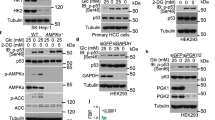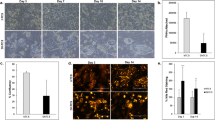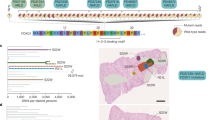Abstract
Phosphorylase kinase-deficient liver glycogenosis manifests in infancy with hepatomegaly, growth retardation, and elevated plasma aminotransferases and lipids. It can be caused by mutations in three different genes of phosphorylase kinase subunits:PHKA2, PHKB, and PHKG2. It is usually a benign condition, often with complete resolution of symptoms during puberty. A minority of patients displays a more severe phenotype with symptomatic fasting hypoglycemia and abnormal liver histology that may progress to cirrhosis. Three patients with liver cirrhosis in childhood analyzed previously all had PHKG2 mutations. This suggested that this genotype may generally cause a more severe clinical manifestation, but to date PHKG2 mutations have been identified in only seven patients. Here, we report mutation analysis in three new patients with liver phosphorylase kinase deficiency and recurrent hypoglycemia, liver fibrosis, and lack of glucagon response but no overt cirrhosis. In all three patients, PHKG2 mutations were found (H89fs[insC], E157K, D215N, W300X). Three of these mutations are novel, bringing the total number of distinct human PHKG2 mutations to 11, found in 10 patients. We conclude that liver phosphorylase kinase deficiency with a severe phenotype, with or without cirrhosis, is indeed often caused by PHKG2 mutations. These patients require active measures to maintain normoglycemia (raw cornstarch, nocturnal tube feeding), which may also alleviate growth retardation and the development of abnormal liver histology.
Similar content being viewed by others
Log in or create a free account to read this content
Gain free access to this article, as well as selected content from this journal and more on nature.com
or
Abbreviations
- ALT:
-
alanine transaminase
- GSD:
-
glycogen storage disease
- Phk:
-
phosphorylase kinase (E.C. 2.7.1.38)
- XLG:
-
X-linked liver glycogenosis
REFERENCES
Chen YT 2001 Glycogen storage diseases. In: Scriver CR, Beaudet AL, Sly WS, Valle D (eds) The Metabolic and Molecular Bases of Inherited Disease, 8th ed. McGraw-Hill, New York, pp 1521–1551.
Kilimann MW 1997 Glycogen storage disease due to phosphorylase kinase deficiency. In: Swallow DM, Edwards YH (eds) Protein Dysfunction and Human Genetic Disease. BIOS Scientific Publishers, Oxford, pp 57–75.
Burwinkel B, Amat L, Gray RG, Matsuo N, Muroya K, Narisawa K, Sokol RJ, Vilaseca MA, Kilimann MW 1998 Variability of biochemical and clinical phenotype in X-linked liver glycogenosis with mutations in the phosphorylase kinase PHKA2 gene. Hum Genet 102: 423–429
Hirono H, Shoji Y, Takahashi T, Sato W, Takeda E, Nishijo T, Kuroda Y, Nishigaki T, Inui K, Takada G 1998 Mutational analyses in four Japanese families with X-linked liver phosphorylase kinase deficiency type 1. J Inherit Metab Dis 21: 846–852
Hendrickx J, Lee P, Keating JP, Carton D, Sadharwalla IB, Tuchman M, Baussan C, Willems PJ 1999 Complete genomic structure and mutational spectrum of PHKA2 in patients with X-linked liver glycogenosis type I and II. Am J Hum Genet 64: 1541–1549
Rudolfova J, Slovackova R, Trbusek M, Peskova K, Stastna A, Kozak L 2001 Identification of three novel mutations in the PHKA2 gene in Czech patients with X-linked liver glycogenosis. J Inherit Metab Dis 24: 85–87
Burwinkel B, Maichele AJ, Aagenaes Ö, Bakker HD, Lerner A, Shin YS, Strachan JA, Kilimann MW 1997 Autosomal glycogenosis of liver and muscle due to phosphorylase kinase deficiency is caused by mutations in the phosphorylase kinase β subunit (PHKB). Hum Mol Genet 6: 1109–1115
van den Berg IE, van Beurden EA, de Klerk JB, van Diggelen OP, Malingre HE, Boer MM, Berger R 1997 Autosomal recessive phosphorylase kinase deficiency in liver, caused by mutations in the gene encoding the β subunit (PHKB). Am J Hum Genet 61: 539–546
Burwinkel B, Moses SW, Kilimann MW 1997 Phosphorylase-kinase-deficient liver glycogenosis with an unusual biochemical phenotype in blood cells associated with a missense mutation in the β subunit gene (PHKB). Hum Genet 101: 170–174
Maichele AJ, Burwinkel B, Maire I, Sövik O, Kilimann MW 1996 Mutations in the testis/liver isoform of the phosphorylase kinase γ subunit (PHKG2) cause autosomal liver glycogenosis in the gsd rat and in humans. Nat Genet 14: 337–340
van Beurden EA, de Graaf M, Wendel U, Gitzelmann R, Berger R, van den Berg IE 1997 Autosomal recessive liver phosphorylase kinase deficiency caused by a novel splice-site mutation in the gene encoding the liver gamma subunit (PHKG2). Biochem Biophys Res Commun 236: 544–548
Burwinkel B, Shiomi S, Al-Zaben A, Kilimann MW 1998 Liver glycogenosis due to phosphorylase kinase deficiency: PHKG2 gene structure and mutations associated with cirrhosis. Hum Mol Genet 7: 149–154
Burwinkel B, Tanner MS, Kilimann MW 2000 Phosphorylase kinase deficient liver glycogenosis: progression to cirrhosis in infancy associated with PHKG2 mutations (H144Y and L225R). J Med Genet 37: 376–377
Willems PJ, Gerver WJ, Berger R, Fernandes J 1990 The natural history of liver glycogenosis due to phosphorylase kinase deficiency: a longitudinal study of 41 patients. Eur J Pediatr 149: 268–271
Wolfsdorf JI 2002 Bones benefit from better biochemical control in type 1 glycogen storage disease. J Pediatr 141: 308–310
Schwahn B, Rauch F, Wendel U, Schönau E 2002 Low bone mass in glycogen storage disease type 1 is associated with reduced muscle force and poor metabolic control. J Pediatr 141: 350–356
Sövik O, de Barsy T, Maehle B 1982 Phosphorylase kinase deficiency: severe glycogen storage disease with evidence of autosomal recessive mode of inheritance. Eur J Pediatr 139: 210
Fernandes J, Huijing F, Van de Kamer JH 1969 A screening method for liver glycogen diseases. Arch Dis Child 44: 311–317
Krebs EG 1966 Phosphorylase b kinase from rabbit muscle. Methods Enzymol 8: 543–546
Tuchman M, Brown BI, Burke BA, Ulstrom RA 1986 Clinical and laboratory observations in a child with hepatic phosphorylase kinase deficiency. Metabolism 35: 627–633
Calalb MB, Fox DT, Hanks SK 1992 Molecular cloning and enzymatic analysis of the rat homolog of “PhK-γT”, an isoform of phosphorylase kinase catalytic subunit. J Biol Chem 267: 1455–1463
Rice NA, Nadeau OW, Yang Q, Carlson GM 2002 The calmodulin-binding domain of the catalytic γ subunit of phosphorylase kinase interacts with its inhibitory α subunit. J Biol Chem 277: 14681–14687
Aikawa J, Ohura T, Iinuma K, Narisawa K 1997 Management of phosphorylase kinase deficiency—outcome and control of phosphorylase kinase deficiency. J Inherit Metab Dis 20: 84
Hanks S, Quinn AM 1991 Protein kinase catalytic domain sequence database: identification of conserved features of primary structure and classification of family members. Methods Enzymol 200: 38–62
Acknowledgements
The authors thank the families for their cooperation, and Drs. H. Rootwelt (Oslo), V. Worthington (London), D. Bali and Y.T. Chen (Durham, NC, U.S.A.) for amplified created restriction sites and enzyme determinations, respectively.
Author information
Authors and Affiliations
Corresponding author
Additional information
Supported by the Deutsche Forschungsgemeinschaft and the Fonds der Chemischen Industrie.
Rights and permissions
About this article
Cite this article
Burwinkel, B., Rootwelt, T., Kvittingen, E. et al. Severe Phenotype of Phosphorylase Kinase-Deficient Liver Glycogenosis with Mutations in the PHKG2 Gene. Pediatr Res 54, 834–839 (2003). https://doi.org/10.1203/01.PDR.0000088069.09275.10
Received:
Accepted:
Issue date:
DOI: https://doi.org/10.1203/01.PDR.0000088069.09275.10
This article is cited by
-
A female patient with GSD IXc developing multiple and recurrent hepatocellular carcinoma: a case report and literature review
Human Genome Variation (2021)
-
Novel PHKG2 mutation causing GSD IX with prominent liver disease: report of three cases and review of literature
European Journal of Pediatrics (2014)
-
Adult monozygotic twins discordant for intra-uterine growth have indistinguishable genome-wide DNA methylation profiles
Genome Biology (2013)



